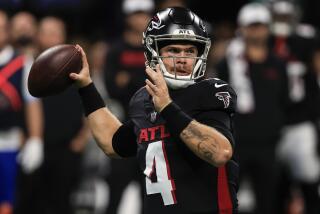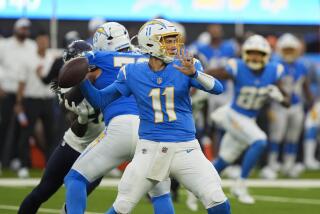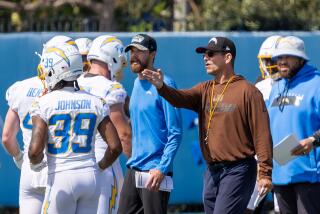Defense Is Top Priority for Chargers : Spanos Views Draft as Opportunity to Get Needed Reinforcements
SAN DIEGO — The best advice that Ron Lynn heard about coaching came early in his career, from an equipment man at San Jose State.
“Put aside two dimes,” the man said. “One for the real estate agent, the other for the moving van.”
Lynn, making allowances for inflation, heeded those words when he assumed subsequent positions, the latest of which brought him to San Diego.
As the new defensive coordinator of the Chargers, Lynn is undertaking one of the more unstable jobs in the coaching profession. So, when he moves into his new home in Del Mar this summer, Lynn will find a safe place to deposit enough small change to cover a couple of phone calls.
In the meantime, he’s looking to the college draft to help cement his job. It’s no small measure of comfort that owner Alex Spanos has targeted the defense to get reinforcement through the draft--or through a trade involving draft choices.
Spanos hopes the Chargers can add three or four defensive starters and an offensive lineman via the draft, which will be April 29. The Chargers have 17 picks, including two in the middle of the first round.
Lynn will settle for one so-called impact player--defensive end, nose guard or linebacker--and go from there.
“I don’t care what position we fill first,” Lynn said. “Any guy we can plug into our front seven should help us. My priority is take whatever new players we get, put ‘em in the most advantageous position, and get ‘em to play like hell.
“But for me to sit here and tell you everything is going to be just fine (after the draft), I better have my hands strapped to my back like a guy in a straitjacket. We’ve got to have a lot more productivity if we’re going to move up from 28th in the defensive rankings.”
The two most important facets of pro football in the last half of the 1980s are getting to the opposing passer, and, conversely, protecting your own quarterback.
The Chargers’ draft will be aimed at these two areas.
The college player the Chargers would most like to have is defensive lineman Jon Hand of Alabama, a 6-foot 6-inch, 280-pound specimen with the potential to rank with Richard Dent, Fred Dean or Mark Gastineau, the game’s top pass rushers.
Others high on the list include Leslie O’Neal of Oklahoma State, T.J. Turner of Houston and Tony Casillas of Oklahoma.
With a dominant young pass rusher, the Chargers would be free to make a series of moves designed to make their defense more aggressive--something Spanos badly wants.
Lee Williams, the team’s most promising pass rusher, could be moved from the left to the right side. Since most teams are right-handed (that is, they put the tight end on the right side most often), Williams would get less harassment from blockers.
Moving Williams also would enable the Chargers to make a nose tackle of Earl Wilson, who made rapid progress in the final month of last season. Wilson would alternate with Chuck Ehin in the middle, thus strengthening that position.
If they don’t get a defensive lineman in the first round, look for the Chargers to select a linebacker who can blitz. Some names to remember: Kevin Murphy of Oklahoma, Alonzo Johnson of Florida and Joe Kelly of Washington.
And don’t be surprised if they also take a 6-6, 300-pound offensive tackle to serve as a bookend for last year’s No. 1 choice, Jim Lachey. The draft may be richer in big, promising blockers than any other position, among them, Joe Milinichik of North Carolina State, Jim Dombrowski of Virginia, Doug Williams of Texas A&M; and Brian Jozwiak of West Virginia.
The Chargers are of two minds when it comes to quarterbacks. They are more than content with Dan Fouts and Mark Herrmann for the next couple of seasons. At the same time, they want to have a replacement ready for Fouts by 1988 or 1989.
By far the most appealing quarterback in the 1986 draft is Iowa’s Chuck Long, who figures to be gone before the Chargers exercise their initial pick, the 13th in the first round.
Consideration was given to trading up in order to have a shot at Long, but Spanos was persuaded it would be more sensible to construct a sounder defense. If, however, Long should be available when the Chargers’ time comes, they might have to reconsider and take him. It’s a decision they don’t really expect or want to make.
Some of Spanos’ closest advisers, including scouting director Ron Nay and assistant head coach Al Saunders, are giving a lot of thought to the direction the team should move in the next few years.
No one in the hierarchy wants to dismantle the gaudy offense assembled and maintained by head Coach Don Coryell. But there is a heightened awareness that playoff appearances tend to accumulate among teams with dominant defensive units and some ability to play ball-control on offense.
It follows that the Chargers may not have to replace Fouts with a quarterback of commensurate stature. If the Chargers can assemble a first-rate defense, they might be willing to concede their title as the league’s most potent offense, as long as they remain among the best.
All this is in the talking stages and may never become policy. Spanos enjoys the fireworks provided by Coryell, Fouts and Co., and he may be reluctant to settle for anything less.
What is certain is that the owner has decreed the Chargers will be an all-out, risk-taking, pressure defense beginning this year, and nothing will interfere with that objective in the draft.
“I want some players who can make a difference on defense right away,” Spanos said. “It would take a lot of convincing by my coaches to get me to change my mind.
“We’ve been trying to make a deal so we could move up, but if we don’t, we’re pretty comfortable where we are. We can’t go wrong. I think there are enough kids who can help our defense that we will have a chance to draft.”
In an attempt to solidify their chances of obtaining Hand, the Chargers have conducted trade talks with both Tampa Bay and Houston, which hold the Nos. 1 and 3 selections. The talks stalled, however, when the Chargers were asked to part with either Gary Anderson or Billy Ray Smith, along with one of their first-round selections.
Anderson and Smith head the list of untouchables on the San Diego roster, which includes Fouts, Kellen Winslow, Tim Spencer and Lionel James. Barring a change of heart, the Chargers wouldn’t give up any of them to get Hand or Long, and maybe not even Bo Jackson, the Heisman Trophy winner who will be the first pick in the draft.
“I guess we’d go for Bo if we could get him, but there are other players who could help us more,” said a Charger executive, who requested anonymity.
The emphasis is on players, plural. Spanos wasn’t being facetious when he said he’d like five or six starters out of this draft. His counselors are known to believe there are as many as nine available holes distributed among the defensive line, offensive line and linebackers, with maybe one more in the secondary.
Almost as urgent as the need for defensive line help is the desire for one or two new linebackers who could fill the breech. Coryell has gone on record with his discontent, which embraced all incumbents but Smith.
The Chargers regard aging Woody Lowe as the Charlie Joiner of the defensive unit. There will be a place for him this year, but he won’t be asked to play every down.
There is hope that Linden King and Mike Green, both of whom slumped last season, will rebound from surgery. The Chargers know there are no draftable players on a level with Lawrence Taylor, Mike Singletary or Andre Tippett, but they believe there are several seniors who compare favorably with a player like Hugh Green in size and skill.
The odds are against them in the effort to land Hand, and there isn’t as much depth among the college defensive linemen as there is in the list of linebackers. For these reasons, it’s possible the Chargers might expend two high picks on linebackers.
“Here’s our dilemma,” said a man familiar with the team’s thinking. “Jon Hand knocked down 14 passes last year, and our defensive coaches are drooling over him. But there’s so much more depth among offensive linemen in this draft.
“Should we take the cream of the offensive line on the first round, or wait until the second round, meanwhile filling other needs in the first round. There are going to be offensive linemen available in the second round who would go in the middle of the first round in other years.”
The Chargers will not take the best available athlete, regardless of position, which was their publicly stated strategy in the past.
Nay explained the current approach:
“We line up every player according to our ratings, and there will be about 270 on our board. If we have four players graded the same, we’d put the guy who fits our need first. If there were four players all rated 6.8 (players who would be likely starters), we would put the man who best fit our needs ahead of the others. But we wouldn’t jump to a player we had rated a 5.8 ahead of a 6.8, even if he was at the position we wanted to fill.”
There are only two positions for which the Chargers definitely would not draft a player in the first round--wide receiver and running back, according to Nay.
The Chargers are reasonably well fortified at receiver, with Joiner, Wes Chandler and Trumaine Johnson, one of last year’s high-priced acquisitions from the USFL. Johnson’s contribution was negligible, but the Chargers are grooming him to replace Chandler or Joiner, whoever wears out first.
Nowhere are the Chargers better stocked than in the offensive backfield. James and Anderson provide mirror-image threats as runners and receivers, while Spencer supplies the utmost in blocking reliability and ball-control potential.
If anything, the Chargers’ anticipation of an upgraded, ball-stripping defense is exceeded by their expectations for Anderson, who has the acceleration, hands and upper body strength to surpass 1,000 yards running and receiving.
Teamed with James, who led the NFL in all-purpose yardage last year, Anderson is bound to keep Air Coryell at the top of the charts, according to Spanos’ lieutenants. Even if Fouts gets hurt again--and injuries have marred his last three seasons--the presence of Anderson, James and Spencer would ease the pressure on Herrmann as the fill-in quarterback.
This line of thinking makes the Chargers less than eager to draft a quarterback from the current crop, which includes Long, Jim Everett, Robbie Bosco and Jack Trudeau.
The quarterback who really excites the San Diego brain trust is Miami’s Vinnie Testaverde, but he won’t be available until the 1987 draft. Linebacker Cornelius Bennett of Alabama is in the same category. The Chargers, should they improve enough to make the playoffs this season, would have to make a trade to have a shot at drafting either Testaverde or Bennett.
There is another issue intertwined with this draft: drugs.
Spanos has taken a staunch, anti-drug stance, which makes it highly unlikely he would draft any of the 57 college seniors who tested positive for drugs in January workouts in New Orleans.
“We definitely wouldn’t use a first-round pick for a guy we know has used cocaine or marijuana,” said a member of the San Diego front office. “But what if there’s a player whom we had rated a first-rounder who was still sitting there in the second round? That’s a harder call, especially if the guy was just suspected of being on pot.
“We got rid of a couple of players last year whom we suspected of using drugs, and they were picked up by other teams. That is a bothersome thing. We don’t want to be in a position where we might get beat by players on drugs when we’re trying to be totally clean. Other teams feel the same way.”
Spanos said he believes he has weeded out all previous drug users, with the exception of linebacker Mike Green and cornerback Danny Walters, both of whom submitted to random drug testing last year and were reportedly clean.
“The only way I’d draft a player (identified as a drug user) would be if he agreed to random testing,” Spanos said.
Drafting drug abusers is risky stuff--and so is trading draft picks. The Chargers are all but committed to a long-term policy of doing neither.
While Spanos built his construction business by taking risks or doing things others wouldn’t, the objective in building the Chargers is to eliminate as many risks as possible.
The Chargers have not ruled out a trade involving draft choices. They recently turned down a deal for a Chicago Bears linebacker with a big reputation. After careful analysis, the Chargers, who declined to name the player, decided his reputation exceeded his true value.
Jon Hand? Yes. Dan Hampton of the Bears? Yes. The Chargers would swap draft picks for such impact players. But the principle being pushed by Saunders and Nay is to stick to the draft, now and in the foreseeable future.
CHARGER DRAFT OUTLOOK
Top Priority:
Charger owner Alex Spanos says he wants 3 or 4 defensive starters and an offensive lineman
The Untouchables:
Gary Anderson, Billy Ray Smith, Dan Fouts, Kellen Winslow, Tim Spencer and Lionel James.
On Quarterbacks:
The Chargers are of two minds when it comes to quarterbacks. They are more than content with Dan Fouts and Mark Herrmann for the next couple of seasons. At the same time, they want to have a replacement ready for Fouts by 1988 or 1989.


